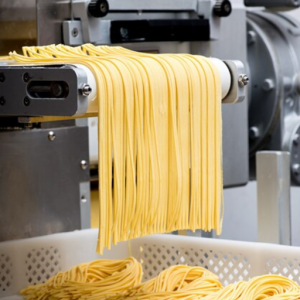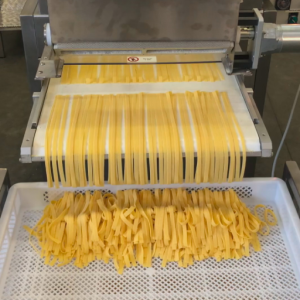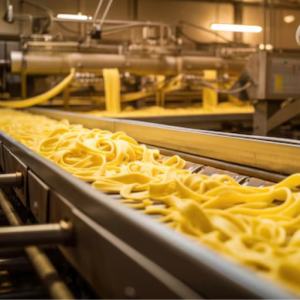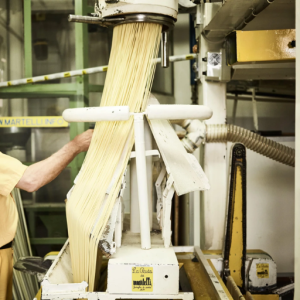Pasta is a staple food for millions of people around the globe. It is easy to make and very versatile. Knowing how fresh and dry pasta is made gives us insight into how these simple ingredients become our favorite meals. In this article, we will look at the pasta production line, fresh vs. dry pasta, machinery used in making them, and methods that guarantee quality and taste. This guide will be useful to culinary students, food industry professionals, or anyone interested in learning more about pasta.
How Does a Pasta Production Line Work?

Image source: https://www.freepik.com/
The steps involved in a pasta production line start with selecting high-quality ingredients and end with packaging. First, durum wheat semolina is mixed with water to form a dough, which needs careful measurements to ensure texture and flavor are consistent throughout the batches. The dough is then kneaded and extruded through different dies, such as spaghetti, penne, fusilli, etc.
Fresh dough sheets can be cut, shaped, and cooked quickly for storage, while dried pasta has a long drying process that removes moisture to extend its shelf life. This makes it available anytime and place for buyers without worrying about spoilage. Additional packaging is done after cooling down to ensure no breakage happens during transportation where goods may get shaken up, leading to some pieces becoming unusable and hence not worth selling anymore but still good enough and should have been kept intact in different containers separated each type its brand name label on the outside showing what’s inside together with other relevant information regarding nutritional values per serving size suggested recipes best suited every particular kind again needed variety sauces match flavors better complementing one another otherwise result might turn out tasting bland unappetizing even though looks appealing visually appetizing mouth-watering sight alone makes your stomach growl loudly demanding attention wants to satisfy hunger cravings right away!
Key Steps in the Pasta Production Process
- Choosing Ingredients: The process starts with durum wheat semolina and water. Wheat quality is key because it influences pasta texture and taste.
- Dough Preparation: To create a uniform dough, the semolina is blended with a specific quantity of water. This mixture is then kneaded to build up its gluten structure, which gives the pasta the desired elasticity.
- Shaping: Different dies can be used to extrude this dough into various pasta shapes. The dough may be rolled out in sheets and cut for fresh pasta, whereas dry pasta is shaped first before being left to dry completely.
- Drying (for Dry Pasta): Moisture needs to be removed under controlled drying conditions for dried pasta to have an extended shelf life and hold its shape during cooking.
- Cooling and Packaging: After cooling down, the dried pasta is packaged by machinery that efficiently preserves quality while preventing breakage. This final step ensures optimal culinary use of the product upon reaching consumers.
Types of machinery Used in pasta production lines
- Mixers: High-capacity mixers are essential when combining semolina with water because they create a homogeneous dough. Only experts should test this machine to determine whether it has achieved the correct moisture level and consistency of the mixture used.
- Extruders: Extrusion machines help shape pasta into its final form by forcing dough through various die shapes, such as spaghetti or penne.
- Dryers: Industrial drying equipment plays an important role in reducing moisture content from products like noodles, which guarantees their long shelf-life
- Cutters: For both fresh or dried varieties, providing consistency and quality at end product cutting machines slice them up accordingly based on predetermined lengths
- Packaging Machines: Suitable materials must be used by automated packaging lines responsible for sealing pastas, thus ensuring freshness besides preventing damages while facilitating distribution faster
Utilizing advanced machinery optimizes the pasta production process, boosting efficiency and maintaining high quality throughout production.
Role of Equipment in Ensuring Quality
Pasta production equipment is essential for ensuring quality at every process stage. High-speed mixers evenly combine ingredients to prevent inconsistencies in dough texture, which can impact the final product. Precision extruders shape the dough while maintaining its integrity, allowing for even cooking by producing consistently thick and shaped pasta. Drying equipment helps achieve proper moisture content; poor drying may cause spoilage or bad cooking results. In addition, automated cutting and packaging machines help control quality by ensuring that pasta is cut to precise specifications and packed to avoid breakage or contamination. Together, these machines increase production efficiency and reduce defects so that a consistently high-quality product meets consumer expectations.
What is the Difference Between Fresh Pasta and Dry Pasta?

The ingredients, texture, and cooking methods of fresh and dry pasta differ. For instance, fresh pasta is made of flour and eggs only. This makes it softer than other types of pasta that take longer to cook. It is typically used in light dishes that require more delicate flavors. On the other hand, dry pasta is tougher as it uses durum wheat semolina mixed with water, making it last longer. It must also be cooked for about 8-12 minutes, much longer than what you would give fresh pasta when making heartier sauces. Each type offers something new to try regarding food experiences based on personal tastes or recipes being followed.
Advantages of fresh pasta
Fresh pasta has several benefits that make it more attractive in different cuisines. First, it’s softer and more tender, absorbing the sauce better, meaning every bite will be flavorful. Second, fresh pasta cooks much faster than dried so you can whip up a meal quickly! Eggs are used to give the pasta its unique taste while also adding protein and nutrients. Mixing different fillings and flavors into fresh pasta is easy, which lets you create new dishes every day! Finally, since fresh pasta doesn’t stay good for long, you have to use healthier fresher ingredients.
Why Choose Dry Pasta?
Dry pasta is usually chosen because it is easy to use and can be used in many ways. One of the best things about dry pasta is its long shelf life; with proper storage, pantry staples can last months without going bad! This feature makes planning meals simple and cooking them when needed. Another benefit of dry pasta is an endless selection of shapes and sizes, such as shells or spaghetti noodles, making dinner fun! When baked casseroles or heavier sauces are on your menu, opt for a dryer since they keep their shape better during cooking than other types. Lastly— but certainly not least— dried pasta tends to be cheaper than its fresher counterparts, therefore appealing financially to families everywhere!
Which pasta line is Best for You?
Finding the perfect pasta line for your needs can be difficult, but a few key considerations can help you make the right decision. First, think about what type of dish you’ll cook and then consider any dietary restrictions or personal preferences. Here are three excellent options:
- Artisan Fresh Pasta: This gourmet product has high-quality ingredients and unique shapes or flavors, making it perfect for special occasions. Artisan fresh pasta works well with lighter sauces that need to be absorbed.
- Whole Wheat Pasta: Whole wheat pasta contains more fiber and nutrients than regular pasta, making it a great choice for health-conscious people. Its nutty taste pairs nicely with robust sauces and hearty vegetables.
- Gluten-Free Pasta: Gluten-free pasta has become much tastier over the years as manufacturers have experimented with different grains, such as rice and quinoa, in response to increasing demand from those who cannot eat gluten-containing foods. These alternatives come in many varieties, so they can be used in any dish without compromising flavor.
Finding the best pasta will depend on your individual tastes and dietary restrictions, so don’t hesitate to try new types until you find one that works perfectly in your kitchen.
What Machinery is Essential for Pasta Factories?

The production process for noodles requires specialized equipment designed just for this purpose; here’s an overview of some important machinery involved:
- Dough Mixers: These mixers are essential because they blend flour and water into one homogeneous mixture (the dough). They also guarantee consistent texture throughout by ensuring an even distribution of moisture within each batch.
- Extruders: These machines shape pasta by pushing through molds of variously shaped strands, such as spaghetti or penne.
- Dryers: Critical in reducing moisture content from cooked noodles, extending their shelf life while preventing spoilage before packaging takes place, thus ensuring the readiness of goods meant for sale to consumers.
- Cutters: These machines cut different lengths of spaghetti at predetermined intervals after extrusion to ensure uniform cooking.
- Packaging Machines: Once produced and dried, packaging machines securely pack pasta into containers/bags, readying them for distribution
Together, these tools simplify the production process, increasing output without sacrificing quality.
Overview of pasta machinery
To ensure its efficiency and quality, pasta manufacturing uses different machines. The following are the most common ones:
- Dough Mixers: These machines mix flour and water evenly to produce a homogeneous dough.
- Extruders: These machines shape pasta by pushing it through different dies, allowing for various product shapes.
- Dryers: By removing moisture from products, dryers elongate shelf life and prevent spoilage during storage or transportation.
- Cutters: For uniform cooking times, extruded pasta must be cut into equal lengths; therefore, cutters are used to do so accurately.
- Packaging Machines: These types of machinery can only wrap and seal final products, ensuring cleanliness and convenience in the distribution process.
The above-mentioned equipment serves as the foundation for making pasta. It allows smooth movement from mixing dough until packing while following all quality regulations.
Key equipment for Different pasta production lines
Different pasta production lines need different machinery depending on their capacity and the type of pasta they produce.
- Continuous Process Extruders: Suitable for large operations, these machines allow a continuous flow of dough, enabling mass production without compromising quality.
- Batch Mixers: Unlike continuous systems, batch mixers are used when making small quantities or special kinds of pasta. They allow flexibility in preparing the dough and changing recipes.
- Cooling and Conditioning Equipment: This is important for some types of pasta because it ensures that after drying, the product does not become brittle due to loss of moisture content.
- Quality Control Stations: Introducing sophisticated inspection systems at various points along the line will improve product quality by checking for consistency in shape, size, and texture throughout the process.
The integration of such machines allows manufacturers to produce a wide variety of pasta, including traditional forms as well as new shapes and formulas, thus satisfying different consumer needs.
Innovations in pasta machine Technology
The latest pasta machine improvements have focused on efficiency, sustainability, and product quality.
- Automation and Smart Technology: IoT (Internet of Things) in the production line of pasta has changed monitoring and control. Manufacturers can now get real-time insights into production performance and equipment health, thereby enabling predictive maintenance, which improves operational efficiencies.
- Environmentally Friendly Machinery: As environmental issues become a concern, there is a move towards energy-efficient machines that minimize water usage and power consumption. Companies are creating renewable energy-powered pasta makers, and bioplastics are being used for manufacturing them to meet sustainability objectives.
- Advanced Drying Technologies: Continuous drying processes using advanced heat exchange methods, among other innovations in drying systems, can achieve faster drying periods without compromising nutritional values or sensory qualities. This not only maximizes output but also extends the shelf life of the products.
Such technological developments address changing consumer tastes, thus making pasta manufacturers competitive in an ever-changing industry.
How to Optimize Production Capacity in a Pasta Factory?

In a pasta factory, production capacity can be optimized by:
- Streamlining Processes: A complete review of production flow should be conducted to establish bottlenecks. Overall efficiency can be improved through simplifying processes and reducing cycle times.
- Invest in Technology: Upgrading machines to higher models greatly enhances speed and quality. Automation decreases manual handling, while reliability increases through smart technologies.
- Maintain Equipment: Downtime is minimized, and service life is prolonged when machines are regularly maintained. A proactive maintenance schedule should be used to avoid unforeseen breakdowns.
- Enhance Employee Training: Regular training for employees ensures they have skills in operating equipment and safety compliance, which increases productivity levels.
- Implement Lean Manufacturing Practices: Lean principles must be adopted to reduce waste and increase material flow. This usually requires reorganizing the manufacturing layout for easier movement within the facility.
- Analyze Demand Patterns: Accurate demand forecasts can only be achieved using data analytics tools. This helps improve production run scheduling, thus ensuring efficient resource allocation in inventory management systems, among other things.
Concentrating on these areas may allow pasta manufacturers to maximize their production capacity and respond adequately to market needs.
Factors Affecting Production Capacity
The production capacity in a pasta factory is significantly affected by several factors:
- Raw Material Quality: The manufacturing process directly affects the quality of ingredients like flour and water. Poor raw materials can cause production delays and inconsistent final products.
- Efficiency of Production Equipment: Machinery performance and reliability are essential. If equipment is outdated or malfunctioning, it will cause increased downtime and slower production rates.
- Workforce Efficiency: Employees’ skill levels determine how efficiently they operate machines during production runs throughout the facility. Trained workers tend to have higher productivity levels because they know what must be done when using different machinery to make pasta.
- External Conditions: Supply chain disruptions, economic fluctuations, as well as regulatory requirements might affect your ability to produce more items within a certain period, which means you won’t reach full capacity for any given time frame until these issues get resolved completely, so keep them in mind while planning! These external challenges can hinder both the availability of raw materials and the distribution of finished products.
Pasta manufacturers can optimize their operations if they understand these factors, which helps them identify possible problems before they arise.
Strategies for Efficient Pasta Production
Manufacturers can adopt several strategies to increase efficiency in pasta production.
- Lean Manufacturing Practices: Implementing lean principles helps eliminate waste at all stages of production. By analyzing workflows and processes, companies can identify inefficiencies and streamline operations, reducing costs and increasing output.
- Automation and Technology Integration: Using advanced machinery and automation technology leads to increased productivity because it speeds up the production lines while minimizing human error. The real-time monitoring of production processes is ensured through automated systems that ensure optimal performance and quick troubleshooting.
- Regular Maintenance and Upgrades: A preventive maintenance schedule for equipment can greatly help reduce unexpected downtimes. Over time, investing in modernized machinery also guarantees competitiveness and efficiency in production capabilities.
These strategies should be applied systematically so that pasta manufacturers can improve their operational efficiency and respond quickly to market changes, thereby increasing profit margins.
Best Practices in Fresh Pasta Production Line Management
To keep quality and efficiency high, managing a fresh pasta production line effectively is essential. Here are some practices that can help:
- Quality Control Systems: Implement strict quality control measures throughout the production process to ensure consistent, fresh pasta. Regular testing of raw materials and finished products helps catch problems before they become widespread.
- Employee Training and Engagement: Teachers should be trained on how to produce better food items such as noodles or spaghetti. When employees are involved in their work, they follow best practices more closely while creating a positive environment for everyone around them.
- Flexible Production Scheduling: To minimize waste and adapt to market demands, different scheduling methods can be used, such as changing batch sizes or altering production times depending on real-time sales data or inventory levels.
Fresh pasta manufacturers will optimize their lines by concentrating on these practices, which will result in high-quality goods that better satisfy consumer preferences.
Why Choose Fresh Pasta Lines for Your Pasta Manufacturing?

There are multiple reasons why you should choose fresh pasta lines for your pasta manufacturing. To begin with, fresh pasta has better taste and texture than dried alternatives, which attracts consumers who want real culinary experiences. Besides that, fresh pasta production requires shorter processing times, allowing quick turnaround from production to market, thereby improving the freshness of the product and its shelf life. Manufacturers can also test different ingredients and flavors when using fresh pasta lines to meet various consumer preferences and dietary requirements. Finally, modernizing fresh pasta leads to increased operational efficiency, thus minimizing wastage, eventually making the business more profitable and sustainable.
Benefits of Specialized fresh pasta lines
Using specialized fresh pasta lines can greatly improve production efficiency and product quality.
- Quality Control Improvement: Machinery explicitly designed for fresh pasta ensures consistent thickness, texture, and overall quality in the pasta produced. This precision results in a high-quality, standard-compliant culinary product.
- Capacity Increase in Production: During peak seasons or launches when there’s high demand for certain products, manufacturers can meet these demands without compromising on their standards because they have specialized equipment that allows them to do so at larger scales.
- Offering Versatile Products: Different shapes and sizes of pasta can be produced using the same line, thus making it easy for manufacturers to diversify their range of products. This flexibility helps them keep up with rapid changes in consumer preferences and market trends.
- Shelf Life Improvement: Specialized lines include advanced preservation methods that extend the shelf life of fresh past while still maintaining its quality, reducing food waste, and increasing profitability.
Investing in this type of machinery gives companies an advantage over competitors since it ensures high-quality production that meets customer needs.
Types of Fresh Pasta Produced
The variety of shapes and sizes that fresh pasta has means it can be used for different types of cooking. Some popular examples are:
- Fettuccine: Flat and ribbon-like, fettuccine is often served with creamy sauces or hearty meat dishes. The wide surface area allows it to hold onto the sauce well.
- Pappardelle: Wider than fettuccine, pappardelle works best with rich sauces and is used in braised dishes featuring either meat or vegetables.
- Ravioli: Cheese, meat, or vegetables are just some of the ingredients in this stuffed pasta dish, which can be boiled, baked, or sautéed before being served alongside a complementary sauce.
- Tortellini: Tortellini resemble ravioli but are small rings instead. They typically contain mixtures of cheese(s) and/or meat and may be served in broth or lighter sauces.
- Lasagna Sheets: Lasagna sheets add comforting layers when baking pasta like lasagna; the sheets can also come dried, so there’s no need to cook them first if you don’t want to!
Manufacturers of these various forms of fresh pasta appeal to different consumers with unique preferences based on cultural trends.
Meeting the Demand for Fresh Pasta in the Market
Manufacturers must take an integrated approach to satisfy the increasing demand for fresh pasta. As seen in current market trends, quality, convenience, and fresh ingredients are becoming increasingly important to consumers. Increased home cooking and a desire for gourmet dining experiences have driven this change.
- Product innovation: Companies are catering to health-conscious customers by including gluten-free or whole-grain options in their product lines. Furthermore, culinary adventurers may be attracted by unusual flavors or fillings.
- Sustainability practices: Brands that prioritize sustainability tend to attract more customers. Local sourcing of ingredients coupled with the use of eco-friendly packaging can enhance brand appeal.
- Strategic distribution: Fresh pasta can be easily accessible through online platforms and meal kit services, thereby reaching wider audiences. Visibility can also be increased through partnerships with chefs and restaurants, which will create a strong presence in the market.
If manufacturers address these factors, they will effectively meet consumer expectations while succeeding in the competitive landscape of fresh pasta production.
Frequently Asked Questions (FAQs)
Q: What is involved in the production of fresh pasta?
A: The production of fresh pasta involves mixing raw materials like flour, eggs, and water, followed by kneading, sheeting, cutting, and shaping the dough into various shapes. High-quality pasta equipment ensures the freshness and texture of the pasta.
Q: What kinds of pasta can be produced using industrial pasta equipment?
A: Industrial pasta equipment can produce various pasta, including short-cut pasta, long-cut pasta like spaghetti, and specialty shapes such as ravioli, tortellini, orecchiette, and tagliatelle. Some equipment is also specialized for gluten-free pasta production.
Q: How do dry pasta lines differ from the production of fresh pasta?
A: Dry pasta lines involve additional steps like heat treatment and drying to remove moisture, ensuring a longer shelf life. In contrast, the production of fresh pasta focuses more on freshness and taste, making it more suitable for immediate consumption or short-term storage.
Q: What is the role of Pama Parsi Macchine in pasta production?
A: Pama Parsi Macchine (Pama Roma) manufactures state-of-the-art machinery and equipment for fresh and dry pasta production. Their lines and equipment are known for reliability and efficiency, serving small pasta factories and industrial-scale pasta makers alike.
Q: How can businesses ensure the production of gluten-free pasta without cross-contamination?
A: To ensure gluten-free pasta production without cross-contamination, businesses must use dedicated pasta equipment and strictly control raw materials. Separate production lines and thorough cleaning protocols are essential.
Q: Why is sheeting important in pasta processing?
A: Sheeting in pasta processing helps achieve the desired thickness and texture of the pasta dough. This step is crucial for producing high-quality pasta, particularly for shapes like lasagne and cannelloni.
Q: What are the benefits of using fully-developed pasta machinery in production?
A: Fully developed pasta machinery ensures maximum quality and consistency in pasta production. Advanced features and automation reduce manual labor, increase efficiency, and improve the final product quality, whether fresh or dry pasta.
Q: How can I learn more about the right pasta machinery for my needs?
A: To learn more about the right pasta machinery for your needs, you can contact specialized manufacturers like Pama Parsi Macchine or use a contact form on their website to request detailed information and consultations based on your specific requirements.
Q: What is the significance of cutting machinery in producing specialty pasta shapes?
A: Cutting machinery is crucial in shaping different kinds of pasta accurately and consistently. It allows the production of specialty pasta shapes such as ravioli, tortellini, and orecchiette, ensuring each piece meets quality standards.














